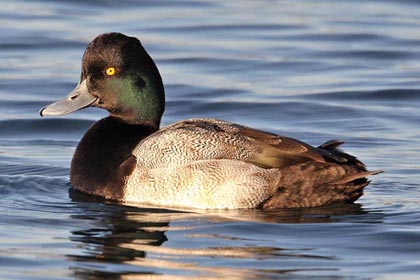Parasitemia, Health, and Reproduction in Lesser Scaup at Red Rock Lakes National Wildlife Refuge
 Investigators:
Investigators:
Andrew Stetter, M.S. Student
Project Supervisor:
Dr. David Haukos
Funding:
U.S. Fish and Wildlife Service
U.S. Geological Survey
Kansas State University
Cooperators:
Red Rocks Lake NWR
Jeff Warren, USFWS
Jane Austin, USGS fe
Location:
Red Rocks Lake NWR
Completion:
August 2014
Status:
Completed
Objectives:
Provide baseline information on scaup health and parasitemia.
Relate parasitemia prevalence and indices of health to body condition and breeding status.
Progress and Results:
Lesser scaup (LESC) populations have been experiencing continent-wide decline since the 1980s. In order to identify factors that may be responsible for recent declines, it is important to have complete understanding of the critical factors influencing population growth/decline (e.g., duckling survival, nesting success, and fitness). We conducted a duckling capture-mark-recapture study using Cormack-Jolly-Seber models in Program MARK to compute apparent daily survival and recapture probabilities for a total of 3,256 individually marked ducklings with 620 recaptures during 2010 to 2013. The most parsimonious model based on a priori hypotheses found that JHATCH2 (Julian hatch date squared) was the most significant predictor of survival and was consistent through all four years. Weight at hatch also was significant as a quadratic effect. Survival was estimated out to time of fledge (i.e., 47 days). During this study, stabilizing selection played a significant role in duckling survival, which indicates that there is trade-off for selection of an optimal timing of hatch on survival and a cost associated with hatching to early or too late.
A large component of breeding success can be attributed to the type of habitat birds choose to nest in. There is a hierarchical process of behavioral and environmental processes that influence habitat selection, which inherently influences the survival and fitness of that individual. I investigated spatial attributes and all relationships between high and low-water levels with habitat attributes of nests using GLM models in SAS, t-tests in R, and Hot Spot Analysis in ArcGIS of 481 nests over eight years. In low-water years, successful nests were on average both 209 m farther from upland and 49 m closer to conspecific nests than unsuccessful nests. Clusters of Hot Spots for nest success overlapped with clusters of nests initiated later in low-water levels and the reverse was true for clusters of Cold Spots for nest failure nests initiated earlier. This relationship of spatial clustering based on the timing of nest initiation and nest success/failure was evident in both water levels. Density-dependence seems to be a factor affecting late-nesting LESC females that are cuing in on the reproductive performance of conspecifics when determining where to nest.
Blood parasites, per se, do not lead to mortality, but instead reduces an individual's health, which may ultimately lead to lower fitness. Blood was drawn from 112 individual adult LESC captured and sampled from 2011-2012via spotlighting and drive-trapping. Parasite prevalence was determined (Table 4), a size-adjusted relative body condition (BCIndex) was calculated for each individual and compared with heterophile:lymphocyte ratio (a proxy for health, hereafter H:LRatio) and JDATE of capture ). H:LRatio was also compared with JDATE of capture. Blood parasites were not an issue for LESC, and individuals in poor health were in poor condition, and BCIndex and H:LRatio decreased seasonally.
Products:
Thesis:
Stetter, A.P. 2014. Nest-site Selection, Duckling Survival, and Blood Parasite Prevalence of Lesser Scaup Nesting at Red Rock Lakes National Wildlife Refuge. Master's Thesis. Division of Biology, Kansas State University. (Advisor: Haukos)
Professional Presentations:
Stetter, A. P., J. M. Warren, and D. A. Haukos. 2014. Nest-Site Selection by Scaup at Red Rock Lakes National Wildlife Refuge. Midwest Fish and Wildlife Conference, Kansas City, MO.
Stetter, A., J. Warren, and D. Haukos. 2014. Duckling survival at the edge of scaup range in Montana. Midwest Fish and Wildlife Conference, Kansas City, MO.
Stetter, A., D. Haukos, and J. Warren. 2013. Parasitemia, health, and reproduction in lesser scaup at Red Rock Lakes National Wildlife Refuge. 6th North American Duck Symposium, Memphis, Tennessee.
Stetter, A., J. Warren, and D. Haukos. 2013. Duckling survival at the edge of scaup range in Montana. Annual Meeting of The Wildlife Society, Milwaukee, Wisconsin.